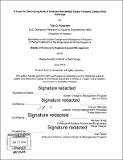A case for electrifying heat in end-use residential sector towards carbon-free buildings
Author(s)
Sodeinde, Tolu O.
Download1119555494-MIT.pdf (12.38Mb)
Other Contributors
Massachusetts Institute of Technology. Engineering and Management Program.
System Design and Management Program.
Advisor
Harvey Michaels.
Terms of use
Metadata
Show full item recordAbstract
Space and water heating account for nearly two-thirds of energy consumption in U.S. homes, and a large contributor to energy costs of end-use residential dwellings. Most home heating systems in the United States are fueled by fossil fuels - natural gas and fuel oil (heating oil) - representing more than 50 percent of all U.S. homes' heating. These heating systems result in higher greenhouse gas emissions than electric heating systems now, and the emissions difference will increase as the grid trends toward lower carbon intensity in the decades ahead. Electrification of residential heating systems, by eliminating site fossil fuel use for heating, provides an important element of ultimately achieving carbon-free buildings. The objective of this research is to analyze the heating load of end-use residential dwellings. The research for this thesis achieves this by first conducting a survey of energy usage profile of some residents in Boston, Massachusetts and Houston, Texas. It then applies a thermal model to simulate building heat load, which was used in developing an electrification cost model to verify and validate the case for electrification of residential dwellings. Thermal models were developed for two cities, Boston and Houston, having contrasting winter weather and electricity rates. The model simulated heat load demand and energy outputs from heat pumps in both cities and analyzed resulting data and potential tradeoffs compared with electric resistance and gas furnace heating systems. Results show that heat in residential dwellings using electric air-source heat pumps (ASHPs) is more cost-effective and energy efficient compared with other heating systems. Model analyses indicate that heat demand in residential dwellings, which increase as outside temperature decreases due to heat loss, is disproportionately higher at low temperatures because the performance of ASHPs drops with outside temperature. However, ASHP performance is higher in Houston compared to Boston due to milder winter temperatures in the former. And the "balance point" between heat load and energy output decreases as capacity of ASHP increases.
Description
Thesis: S.M. in Engineering and Management, Massachusetts Institute of Technology, System Design and Management Program, 2019 Cataloged from PDF version of thesis. Includes bibliographical references.
Date issued
2019Department
Massachusetts Institute of Technology. Engineering and Management ProgramPublisher
Massachusetts Institute of Technology
Keywords
Engineering and Management Program., System Design and Management Program.